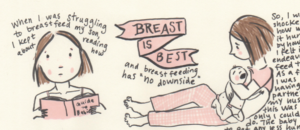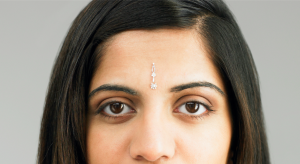
A person with a white shirt on a white background stares into the camera with a neutral expression.
As the Black Lives Matter movement has ramped up over the last few years, conversations about race and policing have reached a fever pitch.
But the often violent intersections of racism and the justice system – and the harm done to communities of color by law enforcement – don’t begin and end with the police.
Rather, racism is entrenched into the justice system, and especially into the prison industrial complex.
But even worse, the racism that shapes our justice system overall is also an outgrowth of racist ideas and myths perpetuated every day by politicians, media, and community leaders across the country.
Often, the mythical villain in their blatantly false representation of this nation’s “crime problem” is a man of color – and typically, he is being criminalized in an effort to use him as a scapegoat for crimes committed, statistically, by mostly white men.
This is no coincidence. Our country’s problem with racism is well-documented and examined here at Everyday Feminism, and it goes without saying that racial tensions coming out of our nation’s history with slavery and even immigration and colonization are far from healed.
But the consequences of the racist narratives shaping our policies and conversations around crime aren’t simply contributing to the attitudes of Americans. They’re destroying the lives of Black and Brown communities across the country.
These racist attitudes also fly in the face of actual statistical data, much of which stands to show not only that men of color are not the perpetrators of a majority of certain crimes, but also that white men typically are.
All too often, our conversations and policies around crimes related to drugs, sexual violence, and terrorism come from a starting point wherein men of color are at the center. A closer look at the facts, however, can help us correct the record.
The following myths have been used for far too long to criminalize men of color, with devastating consequences to their own families and their communities. And all of them simply aren’t true.
The sooner we begin countering them with the truth, the sooner we can get to work tackling the immense task of removing racism from the criminal justice system – and creating a nation where all of us are equal under the law.
Myth #1: Black Men Are More Likely to Use and Sell Drugs
The history of America’s drug policies are intertwined with the history of American racism – and have indelibly been shaped by it.
The “War on Drugs” stands, right now, as one of the most obvious and explicit examples of racist policing and policy-making, and it has had extreme consequences for African-American communities.
By and large, Black communities have been targets of the War on Drugs. This is no accident: Richard Nixon and Ronald Reagan, who oversaw the architecture of what is now the modern drug war, knew that they were enacting a race war instead.
Nixon’s senior advisor would later go on to admit that Black people were “enemies” of the Nixon campaign and White House, that they wanted to associate them with illegal drug use and criminalize them by extension.
Reagan’s administration used the language of war to mount a massive campaign against “urban” threats related to drug crimes, and used that as a launching point for the sentencing laws and unfair policing mechanisms that have since sent entire generations of Black men to prison.
These racist tactics fly in the face of the actual data surrounding drug use and distribution, all of which points to white folks as a majority of drug users and distributors.
According to the NAACP, five times as many white people as Black people use illegal drugs – but Black people are sent to prison ten times more than white folks for drug-related crimes. Black folks are 38% of those arrested and 59% of those in state prison for drug offenses, but make up only 12% of the total population.
Fourteen million white people report using an illicit drug – but only 2.6 million Black people report the same. Twenty percent of white people have used cocaine, compared with only 10% of Black and Latino folks. White people are also more likely to use hallucinogens, smoke weed, pop painkillers recreationally, and use “uppers” without a prescription, too.
Despite all of this, Black people serve as much time in prison for drug offenses as white folks do, on average, for violent crimes.
They’re 12% of drug users, but 32% of those arrested for possession. They’re 45% of those in state prison for drug crimes.
And, as detailed in a policy paper by Kenneth Nunn, the War on Drugs has created policing mechanisms which literally single out and specifically target communities of color for drug use, as well as punish drug crimes differently based on the communities more likely to use specific drugs.
A big example here is the difference in sentencing guidelines for crack and cocaine, which are the same drug at heart, but are used by Black and white people more frequently, respectively.
The consequences of the drug war are many, and for those who are victimized unfairly by these racist policies, the consequences are personal. Because their crimes are classified as felonies, they can be denied public housing assistance, are barred from receiving federal financial aid and some tax credits, and will struggle to find employment due to their record.
For the Black community at-large, the impact – referred to as “the new Jim Crow” by Michelle Alexander – is the loss of entire generations to mass incarceration.
Black people are now one million of the 2.3 million people in prison and are incarcerated at nearly six times the rate of white people. One in six Black men, as of 2001, had been incarcerated. One in three Black men born today can expect to spend time in prison.
The origin of the War on Drugs is racist scapegoating. By purposefully criminalizing communities of color, lawmakers guaranteed the criminal justice system we’re now contending with – as well as the mass incarceration problem tearing communities of color apart.
By pushing back against the racist narrative central to the drug war – and advocating for an end to the racist policies it has put in place – we can restore justice to them.
Myth #2: Latino Men Are Rapists
Donald Trump hasn’t been able to offer up many concrete policies or commitments, but he has been able to, on numerous occasions, accuse Mexican immigrants in particular of being rapists
On multiple occasions, he’s asserted that they’re “bringing crime” to the nation, sparking (righteous) outrage and indignation from Latinx groups – and also most decent human beings.
Beyond being inflammatory, however, Trump’s assertion flies in the face of actual data on sexual violence and crime related to citizenship status. Immigration has increased since the 1990s, but crime has decreased.
Multiple studies have shown that there is no inherent connection between immigrants and criminality – in fact, data shows that first-generation immigrants are less likely to commit crimes than native-born Americans.
In 2013, only 38.6% of federal offenders were undocumented immigrants – and 76% of them were in federal prison because of immigration-related cases. In the same year, only 3.8% of sex abuse offenses were chalked up to undocumented immigrants. On the whole, non-citizens are a smaller proportion of the state prison population than in the US population at-large.
The notion of men of color as rapists, however, is much older than Donald Trump and his circus of a presidential campaign.
In the late 19th century, rhetoric pointing to Black men and, by extension, other men of color and immigrant men, as rapists began to rise up in reaction to the newfound freedom of most slaves.
White folks scapegoated Black men for crimes of sexual violence, ironically often in an attempt to cover up actual consensual relationships between Black men and white women.
The consequence was serious: Black men were lynched and pursued by mobs in reaction to accusations of rape. And now, centuries later, the myth withstands.
The folks putting rape laws on the books during the rise of the myth of the Black rapist were white men – who, it goes without saying, benefitted greatly from shaping the laws around a crime they were also undeniably committing.
By structuring the laws to target men of color, white lawmakers literally exempted themselves from accountability in regards to sexual violence. And this concept is alive and well today in a landscape where sex offenders are overwhelmingly white and male, but white men are less and less likely to face legal consequences for committing sexually violent crimes. Brock Turner’s case is not an outlier, nor is it a mistake.
Nearly 99% of sex offenders are men, and six in ten are white, according to research.
But the myth of the Black or Latino rapist doesn’t just help white men. It actively hurts communities of color. Domestic terrorism ranging from the shooting at a Black church by Dylann Roof to the historic Tulsa riots of 1921 and Rosewood massacre in 1923 – and even the tragic killing of Emmett Till – were all rooted in the myth of the Black man as rapist, specifically of white women.
As feminists, we can surely agree that sexual violence needs to be taken seriously and talked about more by our nation’s public figures and leaders. Our communities have far to go in holding themselves accountable and becoming active in the fight to end rape.
But as feminists, we must also do all we can not to allow racist myths to shape that dialogue any longer.
Myth #3: Men Racialized as Muslim Are Terrorists
After 9/11, policies explicitly profiling men of Middle Eastern descent, perceived Middle Eastern descent, or otherwise racialized as Muslim were put into place. Across areas of life and law enforcement, men perceived to be of Arab descent were ostracized, isolated, and targeted for harassment.
To this day, violence committed particularly by Middle Eastern men is considered “terrorism,” and the threat of “radical Islam” shines on – despite the truth that, in actuality, domestic terrorism committed by white men is a more present and, as of late, common threat to our day-to-day lives.
Research done by Mother Jones in 2015 found that of all the mass shootings in the US to take place since 1982, white men were the perpetrators 64% of the time.
Other studies have revealed that white men are a majority of school shooters – who are 97% male and 79% white.
White men make up a larger percentage of gun owners. And in the years since 9/11, they’ve become pre-eminent signifiers of domestic terrorism. From movie theaters to elementary schools to churches to abortion clinics, Americans have been made to feel less and less safe in the spaces where we spend our everyday lives since 9/11 – not because of global terrorism, but because of white men wielding firearms in public space.
In a post-9/11 world that has also become rife with normalized gun violence, I – and I’m sure many of us – have become accustomed to conversations about two very different yet almost identical concepts: “mass shootings” and “terrorism.”
The difference? That’s easy. White men commit “mass shootings.” Men racialized as Muslim are “terrorists.” The relative connection between these two concepts notwithstanding, it is rare that either category overlaps. Men of color are not afforded the luxury of being diagnosed with mental illnesses and being shown empathy by the media when they commit acts of global terrorism.
White men are never held to the same standard of vilification when they commit acts of domestic terrorism against abortion providers, Black churches, or their schoolmates.
The growing danger of gun culture is not something we can continue to ignore or make pretty for the rest of the world. It puts marginalized communities at particular risk, including women of color and LGBTQIA+ folks, and has shown itself to be unforgiving of all of us.
As feminists, we must demand an end to a growing reliance on gun violence as a problem-solving mechanism, a statement-making strategy. We must demand an end to gun violence. And we must also demand an end to the systemic racism that not only holds men of color unfairly accountable for the actions of a few, but also absolves other men of the crimes of many which shape the fabric of our lives.
***
Systemic and cultural racism go hand-in-hand, and it’s apparent when you stack up these myths about people – and specifically men – of color next to actual crime statistics.
The criminalization of people of color not only upholds racist power structures institutionally, but also socially. Because communities of color are seen as inherently criminal, whiteness is valued both systemically and culturally.
Fixing the narratives around crime won’t just stop innocent people of color from being targeted by police. Correcting the record on criminality won’t just alleviate mass incarceration. Righting these wrongs is instead a pathway to actual justice and cultural equality for people of color across the country.
An entire generation of Black men are growing up in an era where one of three of them will likely spend time in prison during their lives. It’s literally legal in cities like New York and states like Arizona to harass Black and Brown men.
Myths that criminalize people of color enable racist policies and practices that have real impact on the lived experiences of entire communities.
And on top of that, myths that criminalize people of color are simultaneously letting white guys off the hook for some serious stuff. We need to hold people accountable equitably, just as we should assume their innocence equitably. That’s what equality under the law looks like. That’s what a fair justice system should strive for.
As feminists, we know it’s part of our fight to advocate for racial justice no matter what our race. It is absolutely our responsibility to recognize these myths and not only do all we can not to perpetuate them, but to actively campaign against them.
We must take up this mantle. This must be part of our vision for the world: a criminal justice system that looks entirely different than the one we have, and a legal system which isn’t wrapped up in white supremacy.
[do_widget id=’text-101′]
Carmen Rios is a Contributing Writer for Everyday Feminism. She splits her time disparately between feminist rabble-rousing, writing, public speaking, and flower-picking. A professional feminist by day and overemotional writer by night, Carmen is currently Communications Coordinator at the Feminist Majority Foundation and the Feminism and Community Editor at Autostraddle. You can follow her on Twitter @carmenriosss and Tumblr to learn more about her feelings.
Search our 3000+ articles!
Read our articles about:
Our online racial justice training
Used by hundreds of universities, non-profits, and businesses.
Click to learn more




















